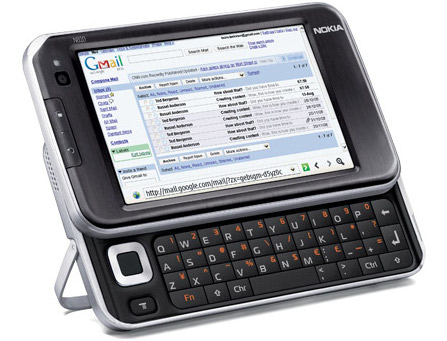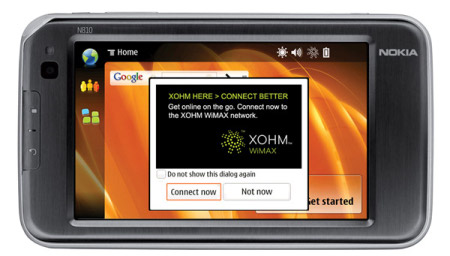Nokia tablet gains WiMAX
Apr 2, 2008 — by Eric Brown — from the LinuxDevices Archive — 9 views Nokia announced a WiMAX version of its Linux-based Nokia N810 Internet Tablet. Aside from the new WiMAX radio, the WiMAX Edition appears to offer identical hardware to the original N810, but offers a pre-installed version of Nokia's new Linux-based “Tablet OS2008” operating system (OS).
Nokia announced a WiMAX version of its Linux-based Nokia N810 Internet Tablet. Aside from the new WiMAX radio, the WiMAX Edition appears to offer identical hardware to the original N810, but offers a pre-installed version of Nokia's new Linux-based “Tablet OS2008” operating system (OS).
(Click for larger view of Nokia N810 WiMAX Edition)
The WiMax Edition is optimized to support Sprint's “Xohm” WiMAX service, which is launching in Chicago, Baltimore, and Washington DC this Spring, with more cities to follow later. Several other devices have recently been announced for use with the service, including the Everex “CloudBook Max” unveiled yesterday, which will use a mobile WiMAX radio chip supplied by GCT Semiconductor, and several Xohm-enabled devices from Linux MID-maker Electrobit (EB).

Nokia N810 WiMAX Edition
WiMAX offers a radius of up to 2-3 miles, says Nokia, in comparison with a few hundred feet for WiFi. The wireless technology is also said to offer much greater download speeds of up to 2-4 Mbps per user, with peak download speeds of up to 10Mbps. Also, unlike WiFi, WiMAX was designed from scratch to deliver seamless handoffs from one base station to another, Nokia said. The market for WiMAX goods and services is slated to grow from $27 million in 2007 to $500 million in 2012, according to recent figures from Strategy Analytics.
Nokia first announced plans to add WiMAX in September of last year, a month before it announced the successor to the original N800 tablet, the keyboard-equipped N810. As announced then, the Nokia N810 Internet Tablet WiMAX Edition uses Intel “Baxter Peak” WiMAX chips, which use the same silicon as Intel's “Echo Peak” MiniCard module for laptops and ultra-mobile devices, but optimized for small form factors and low power consumption.

N810 WiMAX Edition connecting to XOHM
(Click to enlarge)
Like the N810, the N810 WiMAX Edition is based on a Texas Instruments OMAP 2420, clocked at 400MHz, with 128MB DDR RAM, 256MB flash, and 2GB of internal flash memory, supporting flash cards of up to 8GB. The 5.04 x 2.83 x 0.55-inch tablet is equipped with a slide-out QWERTY keyboard, a 4.13-inch LCD with 800×480 resolution, a USB 2.0 port, a webcam, and GPS. When not in range of a WiMAX network, Nokia notes, the Nokia N810 WiMAX Edition can still access the Internet over WiFi, or via a Bluetooth connection to a cellphone.
Although the WiMAX Edition is nearly identical to the N810, it appears to extend the capability of numerous existing functions such as the GPS receiver and the webcam. Applications that Nokia suggests should flourish in a broadband WiMAX environment include its Voice over Internet Protocol (VoIP) and Instant Messaging (IM) clients, such as Skype, Google Talk, and Gizmo5. According to Nokia, its player for the Rhapsody online music service will “transform the Nokia N810 WiMAX Edition into a portable jukebox with millions of songs available.” The GPS capability will be enhanced, it says, with WiMAX access to real-time on-screen maps.
The WiMAX Edition tablet will come standard with a new Tablet OS2008 that is also expected to become available for free download to existing N810 and N800 tablet owners in the second quarter. In addition to software support for WiMAX and Xohm, the update is said to offer an enhanced e-mail client, support for Chinese character rendering in browser and RSS feeds, and automatic periodic software updates, says Nokia.
Availability
Nokia N810 Internet Tablet WiMAX Edition (pricing unavailable) will be made available this summer in the U.S. in locations where Sprint Xohm is available, says Nokia. According to Sprint's estimates, that includes Chicago and the DC/Baltimore region.
This article was originally published on LinuxDevices.com and has been donated to the open source community by QuinStreet Inc. Please visit LinuxToday.com for up-to-date news and articles about Linux and open source.